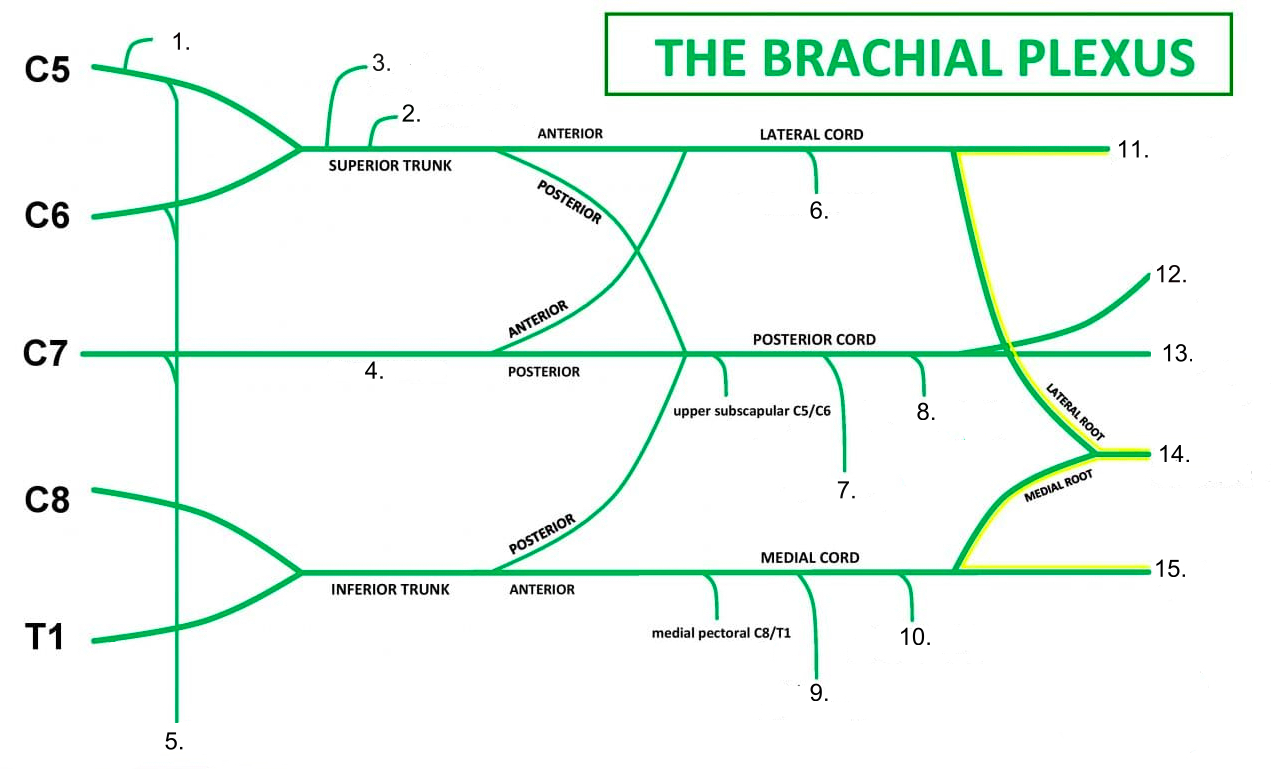Upper Limb
Chapter Conclusion
Learning objectives
- Identify the bones that make up the pectoral girdle
- Identify the muscles that position the shoulder and move the arm
- Identify the major joints in the upper limb
- understand the importance of nerves and blood vessels in the upper limb with emphasis on the median nerve, the carpal tunnel, and brachial plexus
- become aware of the most common shoulder injuries and what muscles/ligaments are affected
Part A.
1. What three bones are part of the pectoral girdle?
a)Humerus, Radius, Ulna
b)Scapula, Sternum, Cervical Vertebra
c)Clavicle, Scapula, Proximal Humerus
d)Ilium, ischium, Pubis
2. What muscles all help position the pectoral girdle
a)Pec Minor, Serratus Anterior, Rhomboid Major
b)Pec major, Biceps Brachii, sternocleidomastoid
c)Supinator, Pronator teres, rectus abdomens
d)Brachioradialis, deltoid, Palmaris longus
3. what type of joint is the shoulder Joint?
a) saddle joint
b)gliding joint
c)ball and socket joint
d)pivot joint
4. three major terminal ends of the brachial plexus are_____.
a)axillary, brachial, C1
b)ulnar, median, radial
c) C1, T1, L1
d) radial, common carotid, pectoral
5. What common injury could be the result of a fall or blow to the shoulder?
a) Fractured spine
b) Depressed shoulder
c) Broken humerus
d) Torn Acromino Clavicular joint
6. Which of the following muscles is not part of the rotator cuff?
a) supraspinatus
b) infraspinatus
c) teres minor
d) subscapularis
7. Which of the following answers is false about latissimus dorsi?
a) one of the actions is medial rotation of the shoulder
b) it inserts on the lateral lip of the intertubercular groove
c) nerve innervation is the thoracodorsal nerve
d) one of the actions is shoulder extension
8. The ligament associated with the shoulder joint that deepens the socket to provide more surface area for the head of the humerus is?
a) trapezoid ligament
b) glenoid labrum
c) transverse humeral ligament
d) glenohumeral joint
9. The largest carpal bone is?
a) trapezium
b) trapezoid
c) capitate
d) hammate
10. Which of the following feature is true with regards to the finger extensors?
a) innervated by the medial nerve
b) all originate on the medial epicondyle
c) they all are positioned on the anterior surface of the forearm
d) none of the above are true
Part B
| Statements | Definitions |
| 1. The pectoral girdle sacrifices __________to maintain a large range of motion
2. The function of the levator scapula is to_______ the scapula 3. rhomboid major originates on the _________. 4. The action of rhomboid minor is adduction and _______. 5 deltoid inserts on the ______. |
a)Deltoid tuberosity
b) Stability c)Downward rotation d) Spinous process of thoracic vertebrae e)elevate
|
Part C

| Questions | Features |
| 1. | A. Musculocutaneous |
| 2. | B. Suprascapular |
| 3. | C. Median |
| 4. | D. Subclavius |
| 5. | E. Lateral Pectoral |
| 6. | F. Axilllary |
| 7. | G.Dorsal Scapular |
| 8. | H. Radial |
| 9. | I. Medial Ante-brachial |
| 10. | J. Middle Trunk |
| 11. | K. Thoracodorsal |
| 12. | L. Medial Brachial Cutaneous |
| 13. | M. Ulnar |
| 14. | N. Long Thoracic |
| 15. | O.Lower Subscapular |
Answer key
Part A.
- c 2. a 3. c 4. b 5. d 6. c 7. b 8. b 9. c 10. d
Part C
1.g 2.d 3. b 4.j 5.n 6.e 7.k 8.o 9.l 10.i 11.a 12.f 13.h 14.c 15.m

